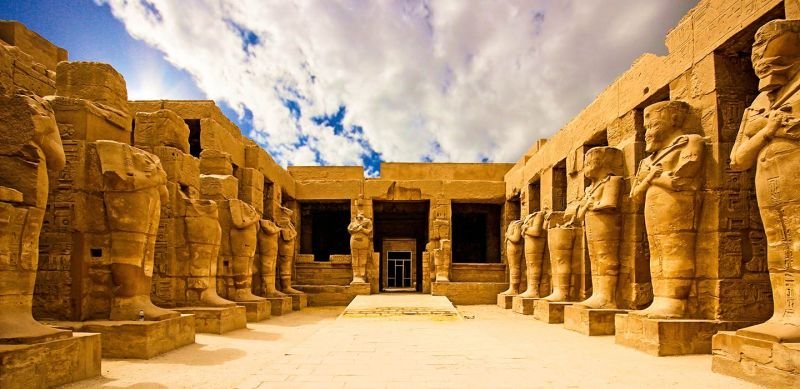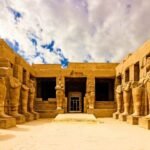
The Egyptian Museum in Cairo stands as a monumental entry point into the history of one of the world’s most enduring civilizations. Located in the heart of Tahrir Square, this unique building was specifically designed to house the globe’s largest collection of ancient Pharaonic art and monuments. Its establishment in 1902 marked a pioneering moment, as it was the first national museum of its kind in the Middle East, symbolizing a new era of cultural preservation for the nation.
An Architectural and Historical Landmark
The museum is more than a repository for artifacts; its very structure is a significant part of Egypt’s national heritage.
A Pioneering Vision for Egyptology
The creation of the Egyptian Museum was the result of a visionary competition launched by the Egyptian Government in 1895, seeking a permanent home for the country’s ancient treasures, which were previously housed in a smaller building in Bulaq. The winning design set a new standard for archaeological museums. Since its inauguration, the museum has been a flagship institution for the study, research, and conservation of ancient Egyptian culture. It is widely considered the mothership of Egyptology and a second home for scholars from around the world. The contributions of ancient Egypt to modern civilization are undeniable, and the Egyptian Museum has played a crucial role in unveiling many of its mysteries.
The Beaux-Arts Masterpiece of Marcel Dourgnon
The building’s design, a neo-classical Beaux-Arts style, is a masterpiece by the French architect Marcel Dourgnon. The facade features a well-proportioned archway flanked by two Ionic columns, with high-relief figures representing Upper and Lower Egypt. While it honors ancient Egyptian iconography, the design’s execution in a late classical Greek style also reflects the western influences prevalent during the time of its construction. The architectural genius extends to its functionality. A distinctive glass ceiling allows natural light to flood the two floors, enhancing the viewing experience. The basement, ingeniously designed with intersecting vaults and supported by pillars, was engineered to support the immense weight of the colossal statues and sarcophagi displayed on the floors above, serving as the perfect place for storing the heaviest antiquities.
A Walk Through History The Unrivaled Collection
Within its walls, the Egyptian Museum in Cairo houses a collection of unparalleled breadth and significance, offering a comprehensive journey through ancient Egypt’s history.
The Vastness of the Collection
Housing over 170,000 artifacts, the museum holds the world’s most extensive collection of Pharaonic antiquities. The exhibits span nearly six millennia, from the Pre-Dynastic Period (c. 5500 BC) to the Graeco-Roman Era (c. AD 364), providing a continuous narrative of one of the world’s oldest and most influential civilizations. The museum’s more than 100 exhibition halls are filled with an extraordinary array of reliefs, sarcophagi, jewelry, papyri, and other objects discovered during archaeological excavations.
Masterpieces and Iconic Artifacts
While the museum’s collection is vast, certain masterpieces and collections are particularly iconic and draw worldwide attention.
The Golden Mask of Tutankhamun and its Current Status
For nearly a century, the golden funerary mask of Tutankhamun has been the most famous centerpiece of the museum’s collection. Crafted from 11kg of solid gold and inlaid with lapis lazuli, glass paste, and turquoise, this masterpiece is a true icon of pharaonic civilization. However, in a major development, the mask is set to be transferred to its new home at the Grand Egyptian Museum (GEM) near the Giza Pyramids. Officials have stated that the mask and two of Tutankhamun’s coffins are among the last 26 items to be relocated, with the move scheduled to occur just ahead of the new museum’s official inauguration in July 2025. This transition marks a monumental new chapter for the legacy of the boy king.
Other Treasures of Tutankhamun’s Legacy
While the mask is the most famous, the wider collection of treasures from Tutankhamun’s tomb remains a key highlight. Other priceless artifacts, such as his ceremonial chair, the gilded wooden cabin for his canopic jars, and a stunning array of gold jewelry, have already been meticulously transferred to the GEM. The new museum is designed to showcase the full collection of over 5,000 items from Tutankhamun’s tomb together for the first time, a spectacle that will be a significant draw for visitors from around the world.
Highlights from the Tanis Collection
Beyond the treasures of Tutankhamun, the museum also houses the magnificent Tanis collection, which is sometimes compared in spectacle to the boy king’s tomb. This less well-known but equally stunning collection features silver coffins, gold masks, royal sarcophagi, and intricate jewelry. The golden funerary mask of King Amenemope, a prominent piece from this collection, remains a key highlight for visitors to the Tahrir museum.
Monuments of the Old Kingdom
Visitors can also witness artifacts from Egypt’s earliest dynasties, including the monumental Statue of Khufu, the Triad of Menkaure, and the wooden statue of Ka-Aper. These pieces offer a glimpse into the foundational periods of ancient Egypt, showcasing the artistic and architectural prowess that would later culminate in the construction of the Great Pyramids.
The Fayum Portraits
The museum is home to a small but fine collection of Fayum portraits. These strikingly realistic and lifelike paintings on wooden panels from the Hellenistic and Roman periods offer an intimate and humanizing view of ancient Egyptians, contrasting with the often monumental and stylized depictions of royalty found throughout the museum.
The New Era Transitioning in a World of Change
The relocation of key artifacts is not a sign of the museum’s decline but rather a strategic evolution of Egypt’s cultural landscape.
The Evolution of Egypt’s Museums
The Egyptian government has embarked on a national strategy to modernize and diversify its cultural offerings. This includes the establishment of new, high-tech venues like the Grand Egyptian Museum and the National Museum of Egyptian Civilization, which recently received the royal mummies of ancient kings and queens, including Ramses II and Hatshepsut. The transfer of Tutankhamun’s treasures to the GEM is part of this broader plan to provide a new type of museum experience that can accommodate large crowds and present an entire collection in a dedicated, climate-controlled setting.
The Relationship with the Grand Egyptian Museum
While the Grand Egyptian Museum will soon house the most famous collection, the historic Egyptian Museum in Tahrir is not closing. It will remain a vital cultural institution, home to approximately 170,000 artifacts. The space vacated by the transfer of the Tutankhamun collection will be filled with a new exhibition on par with its historical significance. This transition offers a unique opportunity for visitors. The Tahrir museum will continue to provide an intimate, “old-style” experience, allowing for a deeper appreciation of its vast and diverse collection, which includes treasures from the Tanis collection and artifacts from Yuya and Thuya, Tutankhamun’s ancestors.
Planning Your Visit to The Egyptian Museum in Cairo
A journey to The Egyptian Museum in Cairo is a foundational part of any trip to Egypt. Proper planning ensures a smooth and enriching experience.
Essential Visitor Information
The museum is open seven days a week, making it accessible for visitors at any time during their stay.
| Category | Details |
| Opening Hours | 9:00 AM to 5:00 PM every day |
| Ticket Office | Closes at 4:15 PM |
| Ticket Price (Foreign Adult) | EGP 550 |
| Ticket Price (Foreign Student) | EGP 275 |
| Video Ticket (Personal Use) | EGP 300 |
Rules and Regulations for a Smooth Experience
To ensure a respectful and safe visit for all, there are several policies to be aware of. Photography with a mobile phone is permitted and free of charge, but flash photography is prohibited to protect the delicate artifacts. Visitors should note that outside food and beverages, as well as large bags, selfie sticks, and tripods, are not allowed inside the galleries. Choosing a guided tour is highly recommended for a more comprehensive understanding of the exhibits and their historical significance.
The Ultimate Guided Tour with nile journeys
While an individual visit is rewarding, a guided tour offers a more profound experience. A licensed Egyptologist guide can provide invaluable context for the artifacts, bringing their stories to life and offering insights that a solo visitor might miss. This is where nile journeys, a leading provider of tailored and all-inclusive tours, offers an unparalleled experience.
The Grand Tour of Cairo: An Immersive Journey
For visitors who want to experience the breadth of Cairo’s historical significance without the hassle of planning, the Grand Tour of Cairo is an ideal choice. This comprehensive 3-night, 4-day package is a complete journey that includes not only a visit to The Egyptian Museum in Cairo but also to the Great Pyramids of Giza, the Sphinx, Old Cairo, and the Citadel of Salah EL Din. The tour is a guided daily trip with all transfers, entrance fees, and even a dinner Nile cruise included. The price for this comprehensive package starts from $369, providing a seamless and enriching way to experience the best of Egypt.
Final Thoughts on an Unforgettable Journey
You have read about the historic grandeur of The Egyptian Museum in Cairo, a place where the past is not merely displayed but lives and breathes. Its walls hold not only the stories of kings and queens but also the very foundation of Egyptology as a field. The treasures of King Tutankhamun may be entering a new chapter, but the museum’s legacy is permanent. It remains a timeless testament to human ingenuity and artistic brilliance, offering a profound journey through the heart of a civilization that has shaped the world. To truly experience this journey, a knowledgeable guide is essential. Consider making your trip a seamless and enriching adventure by exploring the tailored packages offered by nile journeys. Don’t just read about this ancient world—step into it. Secure your place on the Grand Tour of Cairo starting from $369, and let nile journeys guide you through the heart of Egypt. Visit our website to learn more and book your unforgettable journey today.




Leave a comment: